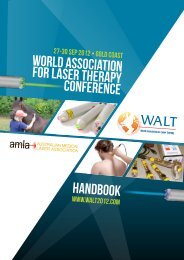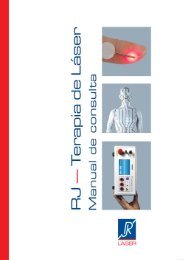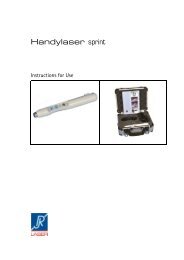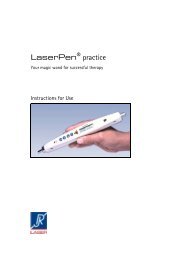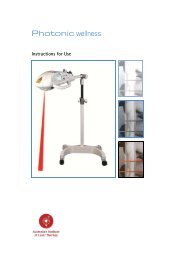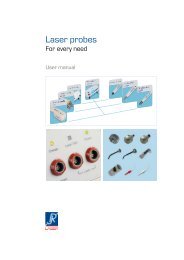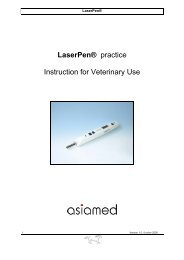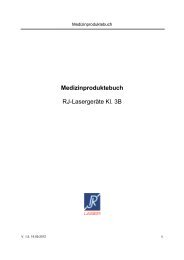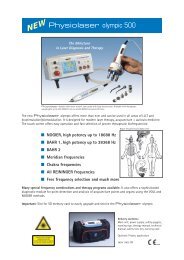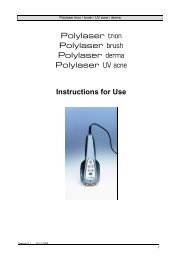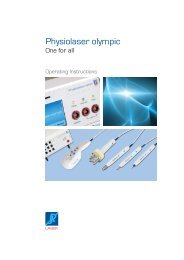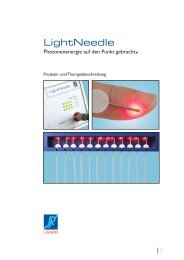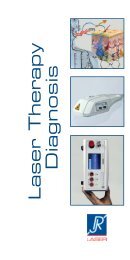LightNeedle - RJ Laser
LightNeedle - RJ Laser
LightNeedle - RJ Laser
Create successful ePaper yourself
Turn your PDF publications into a flip-book with our unique Google optimized e-Paper software.
The fMRI-study was based on a block design with alternating resting conditions for 1 minute and 1<br />
minute of laser needle activation. A total of 6 resting and 6 activation intervals were registered. Each<br />
fMRI data registration required 12 minutes.11,12<br />
Near Infrared Spectroscopy<br />
Near infrared spectroscopic investigations for monitoring laser needle acupuncture were done with the<br />
NIRO 300 Monitor (Hamamatsu Photonics, Japan). Measurement values and changes such as in<br />
oxyhemoglobin and desoxyhemoglobin were determined using the Lambert-Beer principle. Alterations<br />
in parameters could be measured absolutely with this system, but not the level (absolute<br />
concentration) at which these changes (in a positive or negative direction) occur. As long as no<br />
change in concentration was given, the measurement value was zero. The fixating of the sensor<br />
(emitter and near infrared detectors) on the head was done with a silicone holder.<br />
<strong>Laser</strong> Needle Stimulation<br />
As mentioned, laser needle acupuncture (D. Schikora: European Patent PCT/EP 01/08504) allows the<br />
simultaneous stimulation of individual point combinations. Variation and combination of acupuncture<br />
points on the body are possible according to Traditional Chinese Medicine (TCM), or at the ear and<br />
hand using Korean (KHA) or Chinese(CHA) Hand Acupuncture. The laser needle method is based on<br />
a multichannel system with 8 separate semiconductor laser diodes and emission wavelengths of 685<br />
and 785 nm. The system consists of flexible optical light fibers, which conduct the laser light without<br />
loss to the laser needle. Thus, a high optical density at the distal end of the laser needle is achievable.<br />
The intensity of the laser needles is optimized in such a way so that the patient does not feel the<br />
activation of the needle (30-40 mW per needle; diameter 500 mm; duration 10 min; power density 2.3<br />
kJ/cm2 per acupuncture point). More details regarding this method are described in previous<br />
studies.1,6<br />
Volunteers, Animal Experiments, and Procedures<br />
This summarizing study presents a total of 511 measurements in 231 healthy volunteers (129 females,<br />
102 males) with a mean (SD) age of 25 (3.5) years (range, 18-38 years). Protocols were approved by<br />
the local ethics committee, Medical University of Graz, and all volunteers gave their written consent.<br />
None of the volunteers had obvious visual, neurological, olfactory, or mental deficits, or were under the<br />
influence of drugs acting on the central nervous system. A maximum of 7 acupuncture points were<br />
investigated simultaneously in different measurement<br />
series.<br />
Figure 1. Pig (top) and human<br />
experimental (bottom) studies using laser<br />
needle stimulation. Flux (product of<br />
concentration and velocity of<br />
erythrocytes), surface skin temperature,<br />
and room (R) temperature before (a),<br />
during (b-d), and after (e) laser needle<br />
activation.<br />
Animal Experiment (sus scrofa<br />
domesticus), n=1<br />
Modified from: Biomed. Technik,<br />
2004;49:2-5[13]



